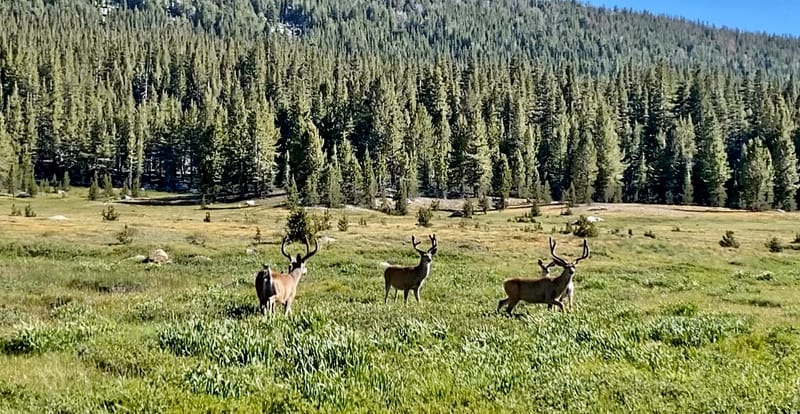Every animal that's endangered or threatened in California in 2025
View the complete list of endangered and threatened animals in California under state and federal law. Learn what these protections mean, how species are classified, and where to find more information about individual animals.
In California, the conservation status of a species is determined under two primary legal frameworks: the California Endangered Species Act (CESA) at the state level and the federal Endangered Species Act (ESA) at the national level.
- Endangered – A species is in serious danger of extinction throughout all, or a significant portion, of its range.
- Threatened – A species is likely to become endangered in the foreseeable future.
- Candidate – A species that is under formal review for potential listing but has not yet received final legal protection. In California, “candidate” status provides temporary CESA protections during the review process.
- Delisted – A species that has been removed from the endangered or threatened list due to recovery, new scientific evidence, or other factors. Delisting can also occur when a species is determined to be extinct.
These designations can apply to an entire species, a subspecies, or a distinct population segment (DPS)—a legal term used under the Endangered Species Act to identify and protect a geographically or genetically distinct population within a species. In California, examples include Southern California steelhead (a DPS of Rainbow Trout also known as Oncorhynchus mykiss) and the mainland California population of the western snowy plover.
Key Differences Between State and Federal Listings
While both systems aim to conserve biodiversity and prevent extinction, state and federal endangered species laws differ in scope, process, and enforcement.
Agencies Involved
- California Fish and Game Commission (FGC) — Oversees the state listing process under CESA, based on scientific recommendations from the California Department of Fish and Wildlife (CDFW).
- U.S. Fish and Wildlife Service (USFWS) — Manages terrestrial and freshwater species under the ESA.
- NOAA Fisheries — Oversees marine species and anadromous fish (species that migrate between fresh and salt water, such as salmon).
Processes and Criteria
- State process (CESA) — A petition triggers a formal review and scientific evaluation. Once the California Fish and Game Commission accepts the petition, the species is granted candidate status and receives interim protection under CESA—regardless of whether it is being considered for a threatened or endangered designation. The commission then makes its final decision based on the “best available scientific information.”
- Federal process (ESA) — A petition or agency-initiated review leads to a 90-day finding and, if warranted, a 12-month status review before a final determination.
Overlap and Discrepancy
A species may be listed by one jurisdiction but not the other, or may have different statuses under each law. This can occur due to variations in listing criteria, timing, or new scientific information becoming available at different times.
Quick Summary of California's Listed Animals
As of July 2, 2025, California has 180 animal taxa listed under state and/or federal endangered species laws. These listings include full species, subspecies, and distinct population segments (DPS).
- State Endangered (SE) — 56 taxa: At serious risk of extinction in California under the California Endangered Species Act (CESA).
- State Threatened (ST) — 43 taxa: Likely to become endangered in California in the near future without conservation action.
- State Candidate (SC) — 11 taxa: Under formal review for possible listing as endangered or threatened in California.
- Federally Endangered (FE) — 91 taxa: At serious risk of extinction across their entire range under the U.S. Endangered Species Act (ESA).
- Federally Threatened (FT) — 51 taxa: Likely to become endangered across their range in the near future without conservation action.
- Federally Proposed (FPE + FPT) — 13 taxa: Proposed for federal listing as endangered or threatened; public review in progress.
- Listed by Both State and Federal Agencies — 61 taxa: Recognized as endangered or threatened by both California and federal authorities.
Note: Numbers include subspecies, Evolutionarily Significant Units (ESUs), and DPS recognized under state or federal law.
State and Federally Listed Animals by Taxonomic Group
Each section can include:
- A brief intro sentence
- A searchable or sortable table
- Notes on nomenclature changes where relevant
Invertebrates
California is home to several invertebrate species that are either state-listed, federally listed, or both. These species range from marine mollusks such as abalones to freshwater shrimp and unique crustaceans found only in the state’s vernal pools.
- Black abalone (Haliotis cracherodii) — Federally Endangered (2009, NMFS; 2011, USFWS).
- White abalone (Haliotis sorenseni) — Federally Endangered (2001, NMFS; 2005, USFWS).
- Morro shoulderband (Helminthoglypta walkeriana) — Federally Threatened (2022, downlisted from Federally Endangered [1995]).
- Trinity bristle snail (Monadenia infumata setosa) — State Threatened (1980). Listed by the state as Monadenia setosa.
- Conservancy fairy shrimp (Branchinecta conservatio) — Federally Endangered (1994).
- Longhorn fairy shrimp (Branchinecta longiantenna) — Federally Endangered (1994).
- Vernal pool fairy shrimp (Branchinecta lynchi) — Federally Threatened (1994).
- San Diego fairy shrimp (Branchinecta sandiegonensis) — Federally Endangered (1997).
- Riverside fairy shrimp (Streptocephalus woottoni) — Federally Endangered (1993).
- Vernal pool tadpole shrimp (Lepidurus packardi) — Federally Endangered (1994).
- Shasta crayfish (Pacifastacus fortis) — State Endangered (1988), State Threatened (1980), Federally Endangered (1988).
- California freshwater shrimp (Syncaris pacifica) — State Endangered (1980), Federally Endangered (1988).
Fish
California’s rivers, lakes, and coastal waters host a variety of fish species that are state or federally listed. Many of these are iconic salmonids and other species tied to the state’s complex water systems.
- Unarmored threespine stickleback (Gasterosteus aculeatus williamsoni) — State Endangered (1971), Federally Endangered (1970).
- Delta smelt (Hypomesus transpacificus) — State Endangered (2009), Federally Threatened (1993).
- Eulachon (Thaleichthys pacificus) — Southern DPS — Federally Threatened (2010).
- Lost River sucker (Deltistes luxatus) — Federally Endangered (1988).
- Shortnose sucker (Chasmistes brevirostris) — Federally Endangered (1988).
- Modoc sucker (Catostomus microps) — Federally Threatened (1985), State Endangered (1980), State Threatened (1989).
- Warner sucker (Catostomus warnerensis) — Federally Threatened (1985).
- Colorado pikeminnow (Ptychocheilus lucius) — State Endangered (1971), Federally Endangered (1973).
- Humpback chub (Gila cypha) — Federally Threatened (1974).
- Bonytail (Gila elegans) — Federally Endangered (1980).
- Owens tui chub (Siphateles bicolor snyderi) — State Endangered (1980), Federally Endangered (1985). Listed by the state as Gila bicolor snyderi.
- Thicktail chub (Gila crassicauda) — State Endangered (1971).
- Cabo San Lucas goby (Gobiosoma atripinnis) — State Endangered (1980).
- Tidewater goby (Eucyclogobius newberryi) — Federally Endangered (1994).
- Coho salmon (Oncorhynchus kisutch) — Southern Oregon/Northern California Coast ESU — State Threatened (2002), Federally Threatened (1997).
- Coho salmon (Oncorhynchus kisutch) — Central California Coast ESU — State Endangered (2002), Federally Endangered (2005).
- Steelhead (Oncorhynchus mykiss) — Southern California DPS — Federally Endangered (1997).
- Steelhead (Oncorhynchus mykiss) — South-Central California Coast DPS — Federally Threatened (1997).
- Steelhead (Oncorhynchus mykiss) — Central California Coast DPS — Federally Threatened (1997).
- Steelhead (Oncorhynchus mykiss) — Northern California DPS — Federally Threatened (2000).
- Steelhead (Oncorhynchus mykiss) — California Central Valley DPS — Federally Threatened (1998).
- Chinook salmon (Oncorhynchus tshawytscha) — Sacramento River Winter-run ESU — State Endangered (1989), Federally Endangered (1994).
- Chinook salmon (Oncorhynchus tshawytscha) — Central Valley Spring-run ESU — State Threatened (1999), Federally Threatened (1999).
- Green sturgeon (Acipenser medirostris) — Southern DPS — State Threatened (2006), Federally Threatened (2006).
- White sturgeon (Acipenser transmontanus) — Klamath River DPS — State Threatened (2024).
Amphibians
California’s amphibians are especially vulnerable to habitat loss, climate change, and introduced predators. Many are endemic to the state and have highly restricted ranges.
- California red-legged frog (Rana draytonii) — Federally Threatened (1996).
- Mountain yellow-legged frog (Rana muscosa) — Southern DPS — State Endangered (2012), Federally Endangered (2002).
- Mountain yellow-legged frog (Rana muscosa) — Northern DPS — Federally Endangered (2014).
- Foothill yellow-legged frog (Rana boylii) — South Coast DPS — State Endangered (2022).
- Foothill yellow-legged frog (Rana boylii) — Central Coast DPS — State Threatened (2022).
- Foothill yellow-legged frog (Rana boylii) — North Coast DPS — State Threatened (2022).
- Sierra Nevada yellow-legged frog (Rana sierrae) — State Endangered (2012), Federally Endangered (2014).
- California tiger salamander (Ambystoma californiense) — Central California DPS — State Threatened (2000), Federally Threatened (2004).
- California tiger salamander (Ambystoma californiense) — Sonoma County DPS — State Endangered (2022), Federally Endangered (2003).
- California tiger salamander (Ambystoma californiense) — Santa Barbara County DPS — State Endangered (2022), Federally Endangered (2000).
- Santa Cruz long-toed salamander (Ambystoma macrodactylum croceum) — State Endangered (1971), Federally Endangered (1973).
- Arroyo toad (Anaxyrus californicus) — Federally Endangered (1994).
Reptiles
California’s reptile diversity includes several species with restricted ranges or specialized habitats, making them particularly vulnerable to human impacts and environmental change.
- Desert tortoise (Gopherus agassizii) — Mojave DPS — State Threatened (1989), Federally Threatened (1990).
- Desert tortoise (Gopherus agassizii) — Sonoran DPS — Federally Threatened (1990).
- Blunt-nosed leopard lizard (Gambelia sila) — State Endangered (1971), Federally Endangered (1967).
- San Francisco garter snake (Thamnophis sirtalis tetrataenia) — State Endangered (1971), Federally Endangered (1967).
- Giant garter snake (Thamnophis gigas) — State Threatened (1971), Federally Threatened (1993).
- Island night lizard (Xantusia riversiana) — Federally Threatened (1977), Delisted (2014).
- Flat-tailed horned lizard (Phrynosoma mcallii) — State Species of Special Concern, Candidate for Federal Listing (previously proposed for listing).
- Coachella Valley fringe-toed lizard (Uma inornata) — State Endangered (1980).
- Peninsular bighorn sheep — (Removed here; belongs under mammals, likely misplaced in some informal lists).
Birds
California’s bird species face threats from habitat loss, climate change, invasive predators, and human disturbance. Many are iconic, with ongoing conservation programs to support recovery.
- California condor (Gymnogyps californianus) — State Endangered (1971), Federally Endangered (1967).
- Bald eagle (Haliaeetus leucocephalus) — State Endangered (1971), State Threatened (1984), Delisted (2016); Federally Threatened (1978), Delisted (2007).
- Golden eagle (Aquila chrysaetos) — Fully Protected in California.
- Western snowy plover (Charadrius nivosus nivosus) — Federally Threatened (1993); Pacific Coast population.
- Marbled murrelet (Brachyramphus marmoratus) — State Endangered (1992), Federally Threatened (1992).
- Brown pelican (Pelecanus occidentalis californicus) — State Endangered (1971), Federally Endangered (1970), Delisted (2009).
- California least tern (Sternula antillarum browni) — State Endangered (1971), Federally Endangered (1970).
- Light-footed Ridgway’s rail (Rallus obsoletus levipes) — State Endangered (1971), Federally Endangered (1970).
- Yuma Ridgway’s rail (Rallus obsoletus yumanensis) — State Threatened (1971), Federally Endangered (1967).
- Northern spotted owl (Strix occidentalis caurina) — State Threatened (2016), Federally Threatened (1990).
- Southwestern willow flycatcher (Empidonax traillii extimus) — State Endangered (1991), Federally Endangered (1995).
- Bank swallow (Riparia riparia) — State Threatened (1989).
- Greater sandhill crane (Antigone canadensis tabida) — State Threatened (1983).
Mammals
California’s listed mammals include some of the state’s most recognizable and charismatic wildlife, from coastal sea otters to elusive desert foxes. Their protection often involves preserving critical habitat, regulating hunting, and addressing human-wildlife conflict.
- Salt-marsh harvest mouse (Reithrodontomys raviventris) — State Endangered (1971), Federally Endangered (1970).
- San Joaquin kit fox (Vulpes macrotis mutica) — State Threatened (1971), Federally Endangered (1967).
- Sierra Nevada red fox (Vulpes vulpes necator) — State Threatened (1980), Federally Endangered (2021, Sierra Nevada DPS).
- Southern sea otter (Enhydra lutris nereis) — State Threatened (1971), Federally Threatened (1977).
- Bighorn sheep — Peninsular Ranges DPS (Ovis canadensis nelsoni) — State Endangered (1998), Federally Endangered (1998).
- Bighorn sheep — Sierra Nevada DPS (Ovis canadensis sierrae) — State Endangered (1974), Federally Endangered (2000).
- Buena Vista Lake ornate shrew (Sorex ornatus relictus) — State Endangered (1980), Federally Endangered (2002).
- Point Arena mountain beaver (Aplodontia rufa nigra) — State Endangered (1971), Federally Endangered (1991).
- Morro Bay kangaroo rat (Dipodomys heermanni morroensis) — State Endangered (1971), Federally Endangered (1970).
- Giant kangaroo rat (Dipodomys ingens) — State Endangered (1987), Federally Endangered (1987).
- Tipton kangaroo rat (Dipodomys nitratoides nitratoides) — State Endangered (1980), Federally Endangered (1988).
- Stephens’ kangaroo rat (Dipodomys stephensi) — State Threatened (1988), Federally Endangered (1988).
- Riparian brush rabbit (Sylvilagus bachmani riparius) — State Endangered (1994), Federally Endangered (2000).
- Riparian woodrat (Neotoma fuscipes riparia) — State Endangered (1994), Federally Endangered (1998).
Fully Protected vs. Endangered/Threatened Species
California law recognizes a special category called Fully Protected species — animals that receive the state’s highest level of legal protection under various provisions of the Fish and Game Code. These protections were established to prevent killing or possessing these species, with very limited exceptions (such as recovery permits for scientific research).
The state also maintains the California Natural Diversity Database (CNDDB) which tracks the status and location of rare animals and plants.
While many Fully Protected animals are also listed as Endangered or Threatened under the California Endangered Species Act (CESA) or the federal Endangered Species Act (ESA), a few are not. Examples include:
- White-tailed kite — Fully Protected, not listed under CESA or ESA, tracked in CNDDB.
- Golden eagle — Fully Protected, not listed, tracked in CNDDB.
- Ringtail cat — Fully Protected, not listed, tracked in CNDDB.
- Trumpeter swan — Fully Protected, not listed, not tracked in CNDDB.
- Northern elephant seal — Fully Protected, not listed, not tracked in CNDDB.
Because the categories operate under different laws, a species’ Fully Protected status does not necessarily indicate its listing status under CESA or ESA. This means:
- Some species are only Fully Protected.
- Some species are only listed as Endangered/Threatened.
- Some species are both Fully Protected and listed, which adds multiple layers of protection and regulatory oversight.
Candidate and Delisted Species
In California’s and the federal listing systems, candidate and delisted statuses provide important context about a species’ conservation journey.
Candidate Species
- State Candidate (SC): A species formally under review by the California Fish and Game Commission for possible listing under the California Endangered Species Act (CESA). During candidacy, it receives many of the same protections as if it were already listed.
- Federal Candidate (FC): A species identified by the U.S. Fish and Wildlife Service or NOAA Fisheries as warranting listing under the Endangered Species Act (ESA) but not yet formally proposed. These species receive no statutory protection under ESA until officially listed, though federal agencies may voluntarily implement conservation measures.
Delisted Species
- Delisted (Recovered): Species removed from state or federal lists because recovery goals have been met and populations are considered self-sustaining under current conditions.
- Delisted (Extinct): Species removed because they are no longer found despite exhaustive surveys. This designation is rare but represents an irreversible loss to California’s biodiversity.
In the California Natural Diversity Database tables:
- Gray-shaded rows indicate delisted species.
- Notes in the status columns often specify whether delisting was due to recovery or extinction.
Understanding these categories helps track species as they move through the listing process—whether toward full protection, ongoing management, or, in the case of recovery, a celebrated removal from the list.
How to Interpret Status Entries
Official species listings often contain more detail than a single name and status. Key points to understand:
- Population segments – A distinct population segment (DPS) is a subgroup of a species that is discrete and significant enough to warrant separate protection status.
- ESUs (Evolutionarily Significant Units) – These are population segments of fish that are genetically distinct and managed separately.
- Subspecies – A taxonomic subdivision of a species with unique traits or distribution.
Because of DPS, ESU, and subspecies distinctions, a single species can appear multiple times in the listings with different statuses for different regions.
Naming differences can also occur — a species’ common name may vary between state and federal sources, and scientific names may reflect recent taxonomic revisions.
More Resources
For further reading, conservation updates, and official listings, refer to:
- California Natural Diversity Database (CNDDB)
- California Endangered Species Act (CESA)
- Federal Endangered Species Act (ESA)
- U.S. Fish and Wildlife Service
- NOAA Fisheries







